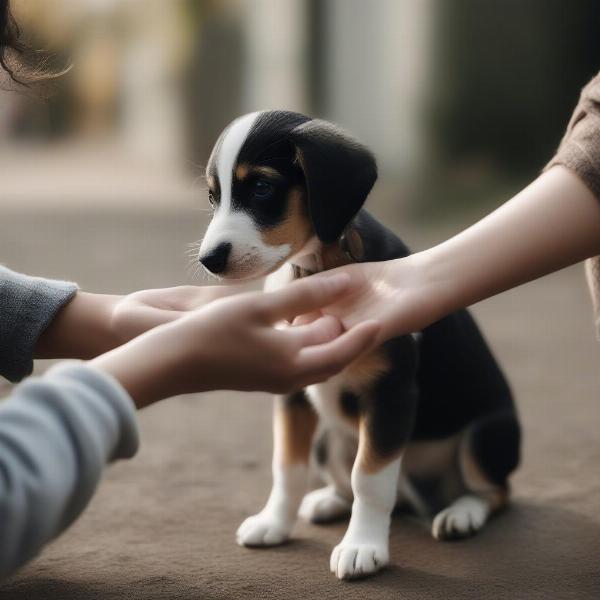No bite spray for dogs is a popular search term for owners struggling with nipping or biting behaviors. While the idea of a quick-fix spray might seem appealing, it’s crucial to understand that these products rarely address the root cause of the problem. This article will delve into effective and humane strategies to address biting, focusing on understanding your dog’s behavior and implementing positive reinforcement techniques.
Understanding Why Dogs Bite
Before searching for a “no bite spray for dogs,” it’s essential to determine why your dog is biting. Is it fear, aggression, playfulness, or something else? Puppies often nip as part of their exploration and play, while older dogs might bite due to pain, anxiety, or territoriality. Identifying the underlying cause is the first step towards a solution. For example, a dog biting out of fear requires a different approach than a dog biting during playful tug-of-war.
Positive Reinforcement: A Better Approach Than No Bite Spray for Dogs
Instead of relying on no bite sprays, which can be aversive and may even exacerbate the problem, positive reinforcement techniques offer a more humane and effective solution. These methods focus on rewarding desired behaviors, such as staying calm and not biting, rather than punishing unwanted actions.
Rewarding Calm Behavior
Reward your dog with treats, praise, or toys when they exhibit calm behavior, especially in situations that typically trigger biting. This teaches them that calmness is more rewarding than biting. Consistency is key; reward even small improvements.
Teaching Bite Inhibition
For puppies, bite inhibition training is crucial. When they nip too hard during play, yelp loudly and immediately stop interacting. This mimics the reaction of other dogs and teaches them to control the pressure of their bite.
 Puppy Bite Inhibition Training
Puppy Bite Inhibition Training
Addressing Underlying Issues
Sometimes, biting stems from deeper issues like anxiety or fear. In these cases, consulting a certified professional dog trainer or veterinary behaviorist is essential. They can assess your dog’s specific needs and develop a tailored behavior modification plan. This may involve desensitization and counterconditioning techniques to help your dog overcome their fears or anxieties.
Seeking Professional Help
Don’t hesitate to seek professional guidance. A qualified trainer can provide valuable insights and personalized strategies that are far more effective than any “no bite spray for dogs.” They can help you understand your dog’s behavior, create a safe environment, and implement a training plan that addresses the root cause of the biting. topical itch relief for dogs
Conclusion: Beyond No Bite Spray for Dogs
While the search for a “no bite spray for dogs” is understandable, addressing the underlying cause of the biting behavior is far more effective and humane. Positive reinforcement, bite inhibition training, and professional guidance are crucial elements in achieving long-term success and building a strong, positive relationship with your dog. Remember, understanding your dog’s behavior is the first step towards preventing bites and fostering a happy, well-adjusted companion.
FAQ
- Does no bite spray really work for dogs? While some sprays might deter biting temporarily, they don’t address the root cause of the behavior and can even be harmful.
- What’s the best way to stop my dog from biting? Positive reinforcement training, combined with addressing underlying issues like fear or anxiety, is the most effective approach.
- When should I seek professional help for my dog’s biting? If the biting persists despite your efforts or if you’re unsure about the cause, consult a certified dog trainer or veterinary behaviorist.
- Is it normal for puppies to bite? Yes, puppies often nip and bite as part of their exploration and play. Bite inhibition training is crucial during this stage.
- Can anxiety cause a dog to bite? Yes, anxiety and fear can be significant triggers for biting behavior in dogs.
- How can I teach my dog bite inhibition? Yelp loudly and stop interacting when your puppy bites too hard. This teaches them to control the pressure of their bite.
- What are some signs of fear or anxiety in dogs? Tucked tail, flattened ears, panting, pacing, and avoidance are common signs of fear or anxiety.
Related Articles:
- insect repellent for dogs homemade
- betagen topical spray for dogs
- grass mites and dogs
- hot spot spray dogs
About ILM Dog:
ILM Dog is your trusted international resource for comprehensive dog care information. We offer expert advice on dog breeds, health, training, nutrition, grooming, and much more, catering to both novice and experienced dog owners worldwide. Whether you’re looking for guidance on choosing the right breed or need tips on training and behavior, ILM Dog is here to support you every step of the way. Contact us at [email protected] or +44 20-3965-8624 for personalized assistance.